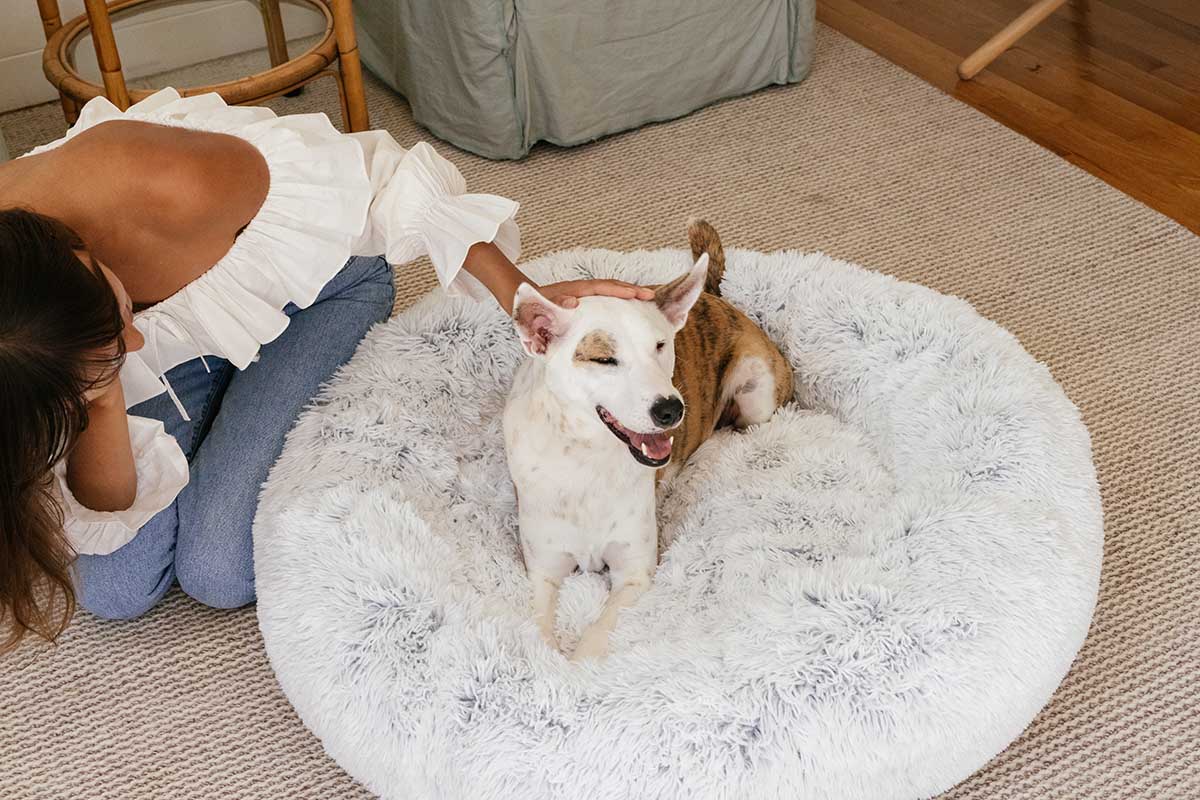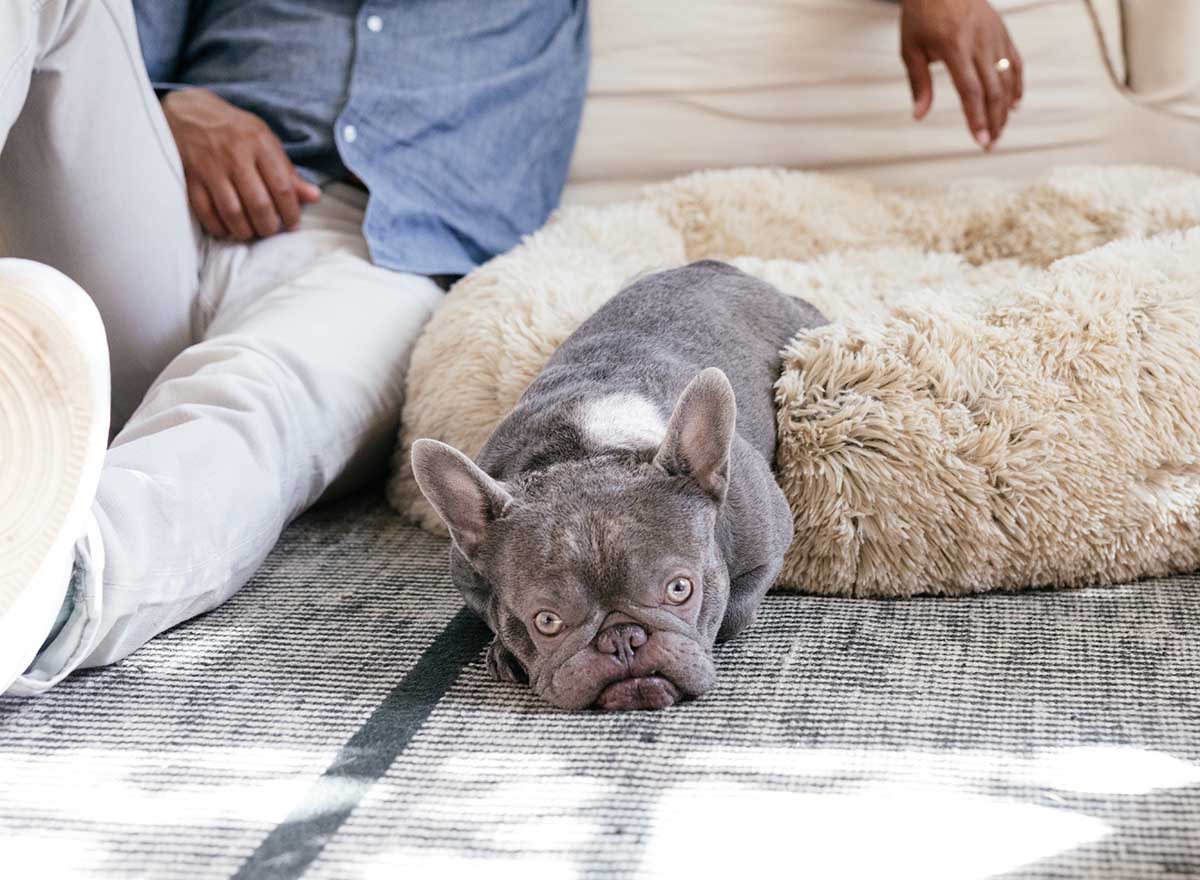The old saying goes, “let sleeping dogs lie” and there is some reasoning behind this! Most of us aren’t too happy about being woken from a deep sleep. The same is true for our dogs.
Being woken out of deep sleep can be startling and disorienting for dogs, which can lead to your dog snapping, lunging, or even biting out of fear.
Bite Risks

None of us like to think we could be bitten by a dog, especially our own, but unfortunately, accidental bites due to human error are not uncommon. The majority of people who experience dog bites are bitten by dogs that they know, including their own dogs. Many of these bites occur because dogs get stressed or startled.
An easy way to startle your dog is by waking them unexpectedly from sleep. Recently there was news that “Duck Dynasty” star Kay Robertson was bitten by her dog. She required stitches and will need plastic surgery. Roberson explained to the press that she considers the bite to be her fault because she had snuck up on her sleeping dog to kiss him goodnight. As a result, the dog was startled and bit her.
This unfortunately isn’t an uncommon situation. We love our dogs, and they love us, but it’s important to remember that while we might consider them our babies, dogs are still dogs. Pay attention to their body language. When dogs get scared or startled, they communicate the only way they can and that often is with their teeth.
Avoid Waking Your Dog

We have high (sometimes unrealistic) expectations of our dogs to be gentle, compassionate, and generally not dog-like. We expect our dogs to live in our homes and allow us to take things (i.e., toys, treats, garbage) out of their mouths, and we wake our dogs without thinking about the consequences.
Dog parents should avoid waking their dogs while they are sleeping and especially avoid waking the dog by touching them.
If you have a dog who you know startles easily when they are awoken from sleep, consider not having your dog sleep in bed with you. In waking them up unintentionally in your sleep, you could startle your dog. Have them sleep in their own dog bed or designated space like a crate.
Veterinary Centers of America (VCA) estimates that 60% of dog bites in children occur when the child wakes or attempts to wake a dog who is sleeping.
Be sure to teach children, guests, and anyone else in your home about how to engage with your dog, and advise them that if the dog is sleeping she needs to be left alone.
If for some reason you do wake up your dog and they react and snap at you, don’t punish them. Instead, take this situation as a lesson for you about needing to give your dog more space while they are sleeping.
If your dog startles awake by snapping or biting, it’s also a good idea to schedule an appointment with your veterinarian for a wellness exam. Your vet will explore if your dog might be in pain from an underlying condition (such as an ear infection) that could lead to this behavior. Your vet will also test your dog for vision and/or hearing loss.
How to Wake Your Dog Safely

In general, if your best friend is sleeping it’s good to let them get their rest undisturbed, however, there are some times when you need to wake your dog up.
For example, if you’re about to leave the house for several hours it’s a good idea to wake your dog first to give them a chance to potty. Similarly, if your dog falls asleep in the car you will need to wake your dog up when you reach your destination.
Lucky in many instances dogs will hear us enter the room or get off the couch and will wake up on their own. However, if you have a dog who sleeps more deeply you may need to be intentional about waking them. A great strategy that will usually prevent your dog from getting startled is to talk more loudly and move around the room until your dog gets up and joins you.
Waking a Deaf Dog
Dog owners who have a dog that is deaf or losing hearing will want to be especially cautious and thoughtful about how they wake the dog when it is sleeping. Because deaf dogs and deaf puppies born with congenital deafness can’t hear you approach, it’s particularly easy for them to be startled when woken up.
When your deaf pet is awake you can try different approaches to get your dog’s attention, including stomping your foot so your dog can feel the vibrations on the floor. Once you have their attention, you can of course communicate with hand signals or American sign language if they learned this in dog training. Another popular approach is gently blowing at your dog’s nose.
Last year the internet fell in love with Aiden Mann, a veterinary assistant who went viral showing videos on his Instagram (@aiden_m365) and TikTok of how he gently blows to wake his deaf and blind dog Plum, and Australian shepherd. In heartwarming videos, Mann demonstrates that by gently blowing on Plum, she wakes up and can orient herself to where he is.
Waking Senior Dogs
Senior dogs have special needs as well. As dogs age, many will lose their hearing and/or vision. These signs of old age can sneak up on people, and it might surprise you to realize that your dog who once could hear you approaching is now surprised. Perhaps they can’t hear your verbal commands as well as they used to.
As a result, your aging dog might start getting more startled when you wake them up. They may be confused about where they are or not be able to see and hear you as well. Just like waking deaf dogs, stomping your foot or blowing on your dog are strategies you might want to incorporate when waking a hard-of-hearing dog who is easily startled.
Common Canine Sleeping Behaviors

Dogs sleep a lot — far more than we do. In general, your furry friend can easily spend up to half of the day sleeping.
When they sleep some dogs are more restless than others. Common sleeping behaviors include shifting frequently from one position to another, snoring, or even running or whimpering in their sleep.
The larger the dog the more time they may spend sleeping, and young puppies and older dogs tend to sleep more than other dogs. Just like people, dogs sleep deeply and experience REM, or rapid eye movement.
Dogs spend approximately 10% of their sleeping time in REM sleep because they tend to sleep in shorter bursts than people do. It’s believed this accounts for why dogs need to sleep so much more than we do. When dogs are sleeping after about 20 minutes of REM sleep they will also dream the same way that we do.
The amount that dogs sleep may also differ by breed. For example, dogs in the Herding or Working groups that are bred with a strong working drive and are active tend to sleep less than other less busy dog breeds. If your dog’s energy levels suddenly shift, however, and you find your dog suddenly sleeping more than usual, it’s a good idea to bring your dog to the vet for a wellness exam.
Proceed with caution

Just like you probably feel better after a good night’s sleep, it’s important for our dogs to get enough sleep as well. Waking a sleeping dog is likely to result in the dog being startled and disoriented. To prevent bites, make sure that visitors and children know not to bother dogs who are sleeping. Waking a sleeping dog can lead to even well socialized and otherwise friendly dogs snapping or even biting.
If you do need to wake a sleeping dog, attempt to do so without touching the dog to prevent the risk of bites. Sleep is essential for a dog’s health and comfort. Uninterrupted sleep whenever possible is in your and your dog’s best interest.

